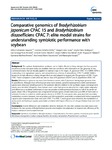Please use this identifier to cite or link to this item:
http://www.alice.cnptia.embrapa.br/alice/handle/doc/989259| Title: | Comparative genomics of Bradyrhizobium japonicum CPAC 15 and Bradyrhizobium diazoefficiens CPAC 7: elite model strains for understanding symbiotic performance with soybean. |
| Authors: | SIQUEIRA, A. F.  ORMEÑO-ORRILLO, E.   SOUZA, R. C.   RODRIGUES, E. P.   ALMEIDA, L. G. P.   BARCELLOS, F. G.   BATISTA, J. S. S.   NAKATANI, A. S.   MARTÍNEZ-ROMERO, E.   VASCONCELOS, A. T. R.   HUNGRIA, M.   |
| Affiliation: | ARTHUR FERNANDES SIQUEIRA, UEL; ERNESTO ORMEÑO-ORRILLO, Universidad Nacional Autónoma de México; RANGEL CELSO SOUZA, Laboratório Nacional de Computação Científica; ELISETE PAINS RODRIGUES, UEL; LUIZ GONZAGA PAULA ALMEIDA, Laboratório Nacional de Computação Científica; FERNANDO GOMES BARCELLOS, UEL; JESIANE STEFÂNIA SILVA BATISTA, UEPG; ANDRE SHIGUEYOSHI NAKATANI; ESPERANZA MARTÍNEZ-ROMERO, Universidad Nacional Autónoma de México; ANA TEREZA RIBEIRO VASCONCELOS, Laboratório Nacional de Computação Científica; MARIANGELA HUNGRIA DA CUNHA, CNPSO. |
| Date Issued: | 2014 |
| Citation: | BMC Genomics, v. 15, n. 420, June 2014. |
| Pages: | 20 p. |
| Description: | The soybean-Bradyrhizobium symbiosis can be highly efficient in fixing nitrogen, but few genomic sequences of elite inoculant strains are available. Here we contribute with information on the genomes of two commercial strains that are broadly applied to soybean crops in the tropics. B. japonicum CPAC 15 (=SEMIA 5079) is outstanding in its saprophytic capacity and competitiveness, whereas B. diazoefficiens CPAC 7 (=SEMIA 5080) is known for its high efficiency in fixing nitrogen. Both are well adapted to tropical soils. The genomes of CPAC 15 and CPAC 7 were compared to each other and also to those of B. japonicum USDA 6T and B. diazoefficiens USDA 110T. Differences in genome size were found between species, with B. japonicum having larger genomes than B. diazoefficiens. Although most of the four genomes were syntenic, genome rearrangements within and between species were observed, including events in the symbiosis island. In addition to the symbiotic region, several genomic islands were identified. Altogether, these features must confer high genomic plasticity that might explain adaptation and differences in symbiotic performance. It was not possible to attribute known functions to half of the predicted genes. About 10% of the genomes was composed of exclusive genes of each strain, but up to 98% of them were of unknown function or coded for mobile genetic elements. In CPAC 15, more genes were associated with secondary metabolites, nutrient transport, iron-acquisition and IAA metabolism, potentially correlated with higher saprophytic capacity and competitiveness than seen with CPAC 7. In CPAC 7, more genes were related to the metabolism of amino acids and hydrogen uptake, potentially correlated with higher efficiency of nitrogen fixation than seen with CPAC 15. Several differences and similarities detected between the two elite soybean-inoculant strains and between the two species of Bradyrhizobium provide new insights into adaptation to tropical soils, efficiency of N2 fixation, nodulation and competitiveness. |
| Thesagro: | Soja |
| NAL Thesaurus: | Soybeans |
| ISSN: | 1471-2164 |
| DOI: | 10.1186/1471-2164-15-420 |
| Type of Material: | Artigo de periódico |
| Access: | openAccess |
| Appears in Collections: | Artigo em periódico indexado (CNPSO)  |
Files in This Item:
| File | Description | Size | Format | |
|---|---|---|---|---|
| ComparativegenomicsofBradyrhizobiumjaponicumCPAC15andBradyrhizobiumdiazoefficiensCPAC7elitemodelstrainsforunderstandingsymbioticperformancewithsoybean.pdf | 2,81 MB | Adobe PDF |  View/Open |









